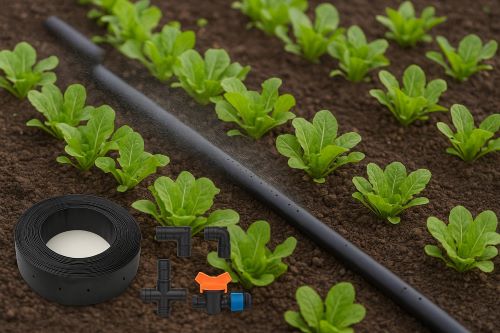


This blog examines why and how drip irrigation works equally as well—if not better in small areas than in expansive agricultural fields.
Modular drip systems are available. Tubes, emitters, connectors, filters, and a water source are the same whether you are cultivating 100 plants or simply five. Depending on your requirements, it scales up or down.
The core idea remains consistent: minimise water waste, maximise root-zone hydration.
Unlike flood irrigation or sprinklers, drip doesn’t depend on land size. It depends on the intention to water smartly.
Small farms, kitchen gardens, rooftop growers, and even schools with edible learning gardens successfully use drip systems. Here’s why:
For instance, in Hyderabad’s gated apartments, residents use balcony-mounted tanks and gravity-based drip kits to grow tomatoes, tulsi, and curry leaves. In Goa, eco-tourism cottages rely on drip-fed vertical gardens to keep herbs fresh year-round.
When setting up such gardens, it helps to buy drip irrigation accessories designed for pots, raised beds, or microtubes to fit compact layouts. These kits allow flexible installation without needing technical expertise.
Not at all. The most basic drip setup can be created under ₹800. It includes:
There’s no need for pumps, electricity, or even timers in many cases. Gravity-fed systems from a raised tank can water up to 20 containers. And most setups take under two hours to install with a pair of scissors and basic fittings.
For comparison:
|
Feature |
Small Drip Setup |
Manual Watering |
|
Water Use (weekly) |
25–40 liters | 60–80 liters |
| Time Required (per day) | 5–10 minutes |
20–30 minutes |
|
Soil Disturbance |
Minimal | Frequent |
| Plant Health Consistency | High |
Variable |
Drip systems stabilize soil moisture and prevent overwatering, a common issue in smaller pots or mixed garden beds.
Drip irrigation for small gardens requires minimal upkeep. The most common tasks include:
Inspecting and cleaning a basic system takes less than 10 minutes as part of a weekly gardening routine.
“Small gardens deserve precision just as much as big farms. The plant doesn’t care about your acreage, it cares about your consistency.”
Yes. Drip irrigation suits almost every plant species, provided you adjust emitter flow based on water needs. For example:
In mixed gardens, zoning is helpful. You can run two separate lateral lines: one for thirsty crops and another for drought-tolerant species.
Using inline drippers placed slightly deeper in the soil enhances root growth and stability for deep-rooted pot plants.
Myth: Drip systems are only for commercial farms.
Reality: Due to limited water availability, balcony gardens and terrace farms benefit greatly from drip.
Myth: It’s too technical.
Reality: With pre-assembled kits and basic tools, anyone can install a system.
Myth: It’s too costly for small-scale.
Reality: Initial costs are low, and savings in water and time pay off quickly.
Myth: Drip irrigation wastes water.
Reality: Drip reduces evaporation and runoff—ideal for water-scarce regions.
